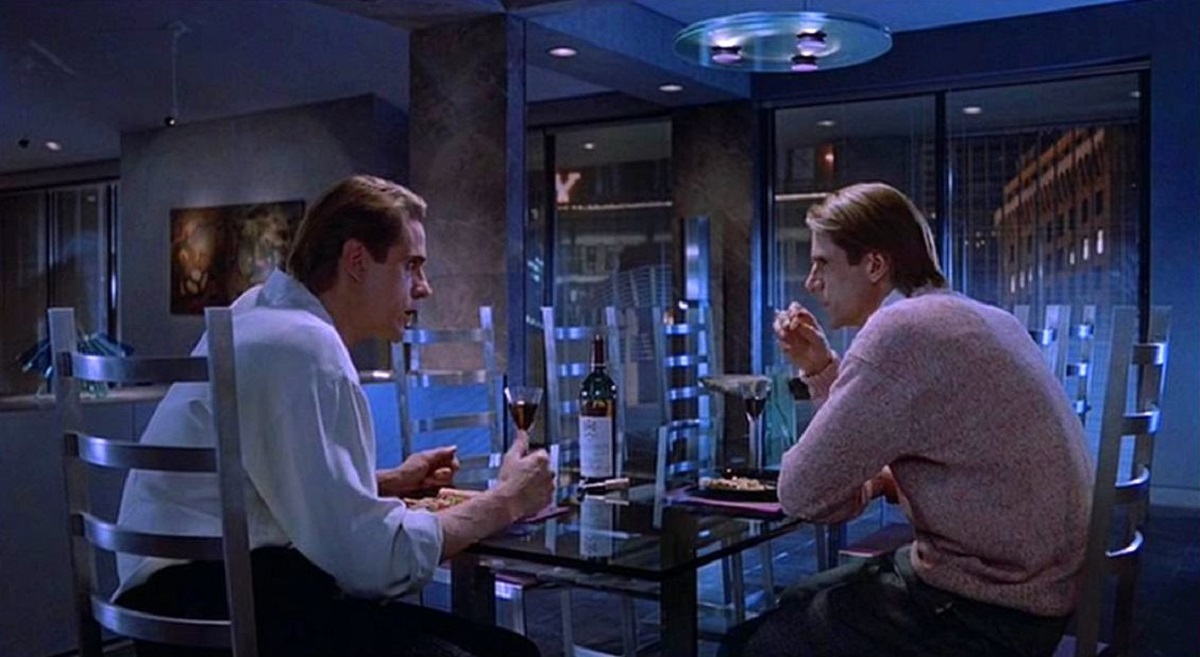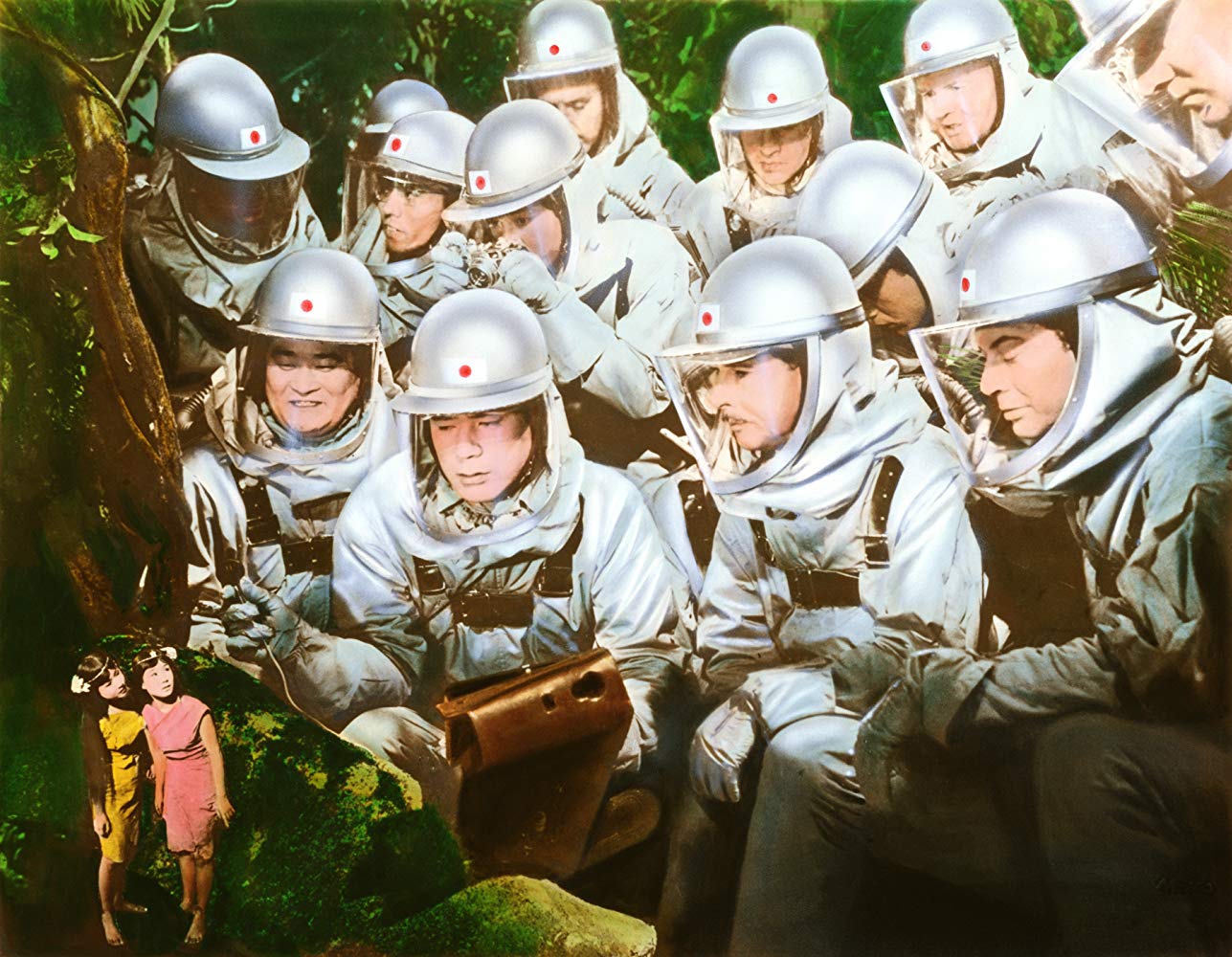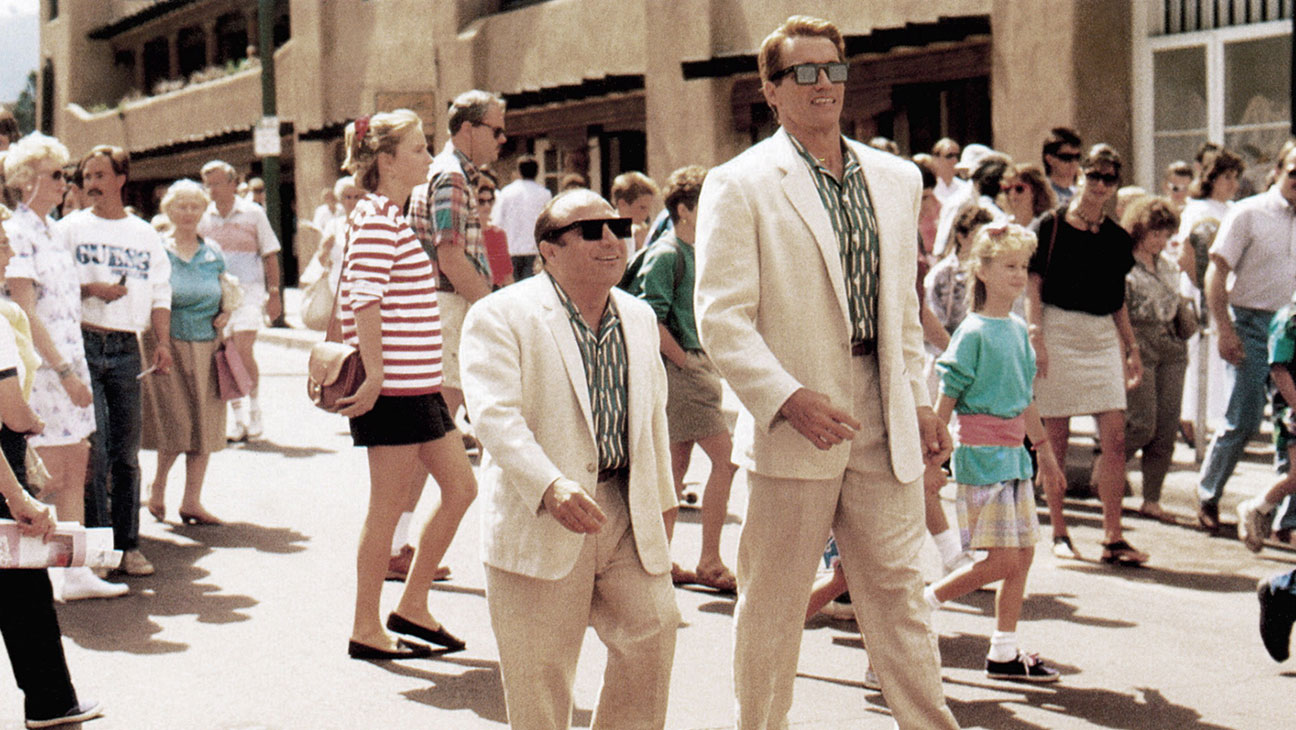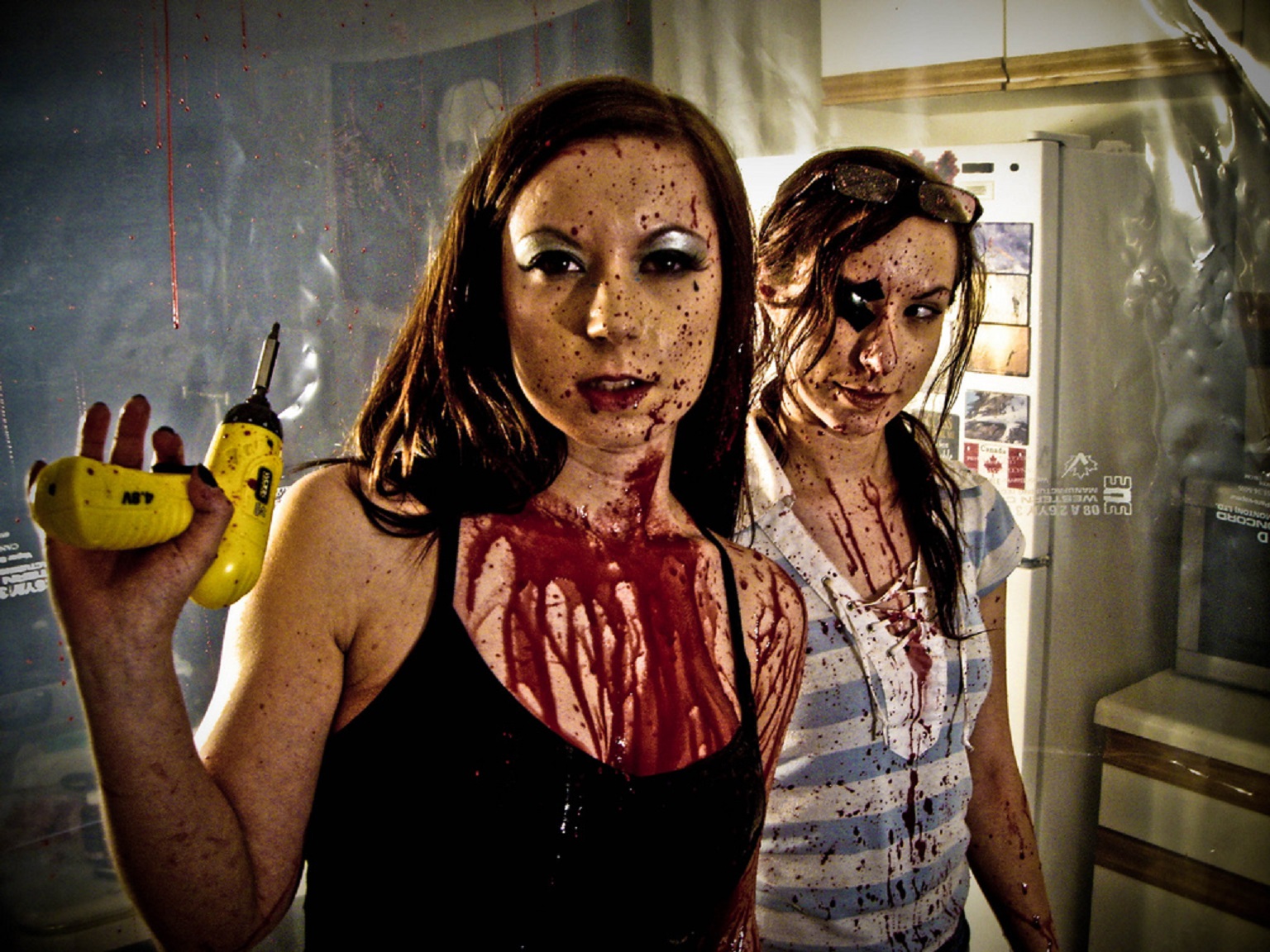Twins are genetically duplicate siblings. This is a real world phenomenon and not an inherently fantastic one. In cinema however there are a number of fantastic variants on the theme.
The most frequent of these variants is the good twin/evil twin theme, which plays out usually in a series of psycho-thrillers usually involving masquerade and identity swapping/theft.
Another common theme is the (real world) belief that twins share a psychic connection – a number of films feature twins that display unusual mental abilities or at least are able to intuitively communicate.
Twins in Fantastic Cinema deals with the varied ways that twins appear on screen in fantastic films. For other copies of individuals see Doppelganger Films and Films About Clones and Cloning.
Good Twin/Evil Twin
The most common of twin themes is the good twin/evil twin trope, which usually involves games of identity confusion, theft and masquerade. A number of films involve plots in which one twin leads a good and upstanding life before the other twin, who may have been psychiatrically incarcerated or that the good twin did not know about, reappears and takes over their life and/or starts stalking them and those around them.
The first treatment of the good twin/evil twin theme in genre cinema was The Black Room (1935) with Boris Karloff as a despotic 19th Century European ruler who masquerades as his more benevolent brother. The standout treatment of the theme was in Shinya Tsukamoto’s Gemini (1999) where an upstanding doctor has his life taken over and stolen by a twin he never know about and he is banished to the bottom of a well.
Other examples of this story include Among the Living (1941), The Dark Mirror (1946), Dead Ringer (1964), The Ninth Confirguration (1979), The Initiation (1984), The Mark of Cain (1985), Blood Rage (1987), Scissors (1991), Alone with a Stranger (2000), The Tiger’s Tale (2006), The Absent (2011), House of Mirrors (2012) and The Evil Twin (2021).
The good twin/evil twin plot was played for comic effect in Ernest Goes to Jail (1990) and as part of an incomprehensible scheme in Southland Tales (2006). One variant on this was the Hammer film Twins of Evil (1971) where one of the twins becomes a vampire. Samaritan (2022) features twin brothers, one of whom has become a superhero, the other a super-villain

The games of masquerade were used with unique effect in The Prestige (2006) where part of stage magician Christian Bale’s creation of an apparent teleportation effect involved the use of a twin. In Whispers (1990), twins are revealed as the explanation of how a man can be killed but reported alive at the same time. A similar twist appears the Cyberpunk film Chrysalis (2007), while in Rocktober Blood (1984), a twin is part of the eventual rationalised explanation as to why an executed killer is seemingly returned from the dead and is killing again. Meridian (1990) concerns twin brothers afflicted with a werewolf transformation curse.
Another variant on the good twin/bad twin theme came with The Other (1972) featuring two twin boys before a twist ending that revealed that one of the twins was dead and existed only in the living twin’s mind. Variants on the imaginary twin twist have appeared in Sisters (1973), Alone (2007), The Absent, Seeing Heaven (2010) and Goodnight Mommy (2014) and its lesser English-language remake Goodnight Mommy (2022).
The definitive work about twin psychology – and almost certainly the work that killed further cliches about good and bad twins – was David Cronenberg’s masterpiece Dead Ringers (1988) with Jeremy Irons giving a tour-de-force as twin brothers who descend into an obsession with gynaecology, drug addiction and sexual fetishism.
Twin Psychic Links
A frequent other theme in fantastic cinema is the belief that twins share a psychic connection, although no proof of this has ever been demonstrated in the real world beyond anecdotal stories.
A number of films feature twins that display unusual mental abilities or at least the ability to intuitively communicate. Examples of psychic twins include Nothing Underneath (1985), Cassandra (1987), Jack’s Back (1988), When the Bough Breaks (1995), I Know Who Killed Me (2007), Under the Mountain (2009), Hereafter (2010) and The Forest (2016).
One of the better works on twin psychic links was the British children’s tv mini-series The Gemini Factor (1987) about boy-girl twins who are opposites in personality and the mysterious psychic connection that draws them together. One of the best examples of this was Seconds Apart (2011) featuring malevolent twins with considerable ability of psychic control over others.

One strange variant was the Kurt Vonnegut adaptation Slapstick of Another Kind (1982) in which two imbecilic twins prove to be alien geniuses when together. A decided oddity was The X Files episode Roland (1994) features the frozen head of a dead scientist kept in suspended animation mentally controlling his autistic twin brother to complete his research and kill.
Dragonheart: Battle for the Heartfire (2017) features a twin brother and sister who share empathic links to a dragon but are on opposing sides of a conflict. Also to be included here might be the miniature twin sisters that appear in Mothra (1962) and have a psychic ability to control the creature.
Conjoined Twins
The most famous of all literary stories is Alexandre Dumas’s The Corsican Brothers (1844) about two conjoined brothers who remain psychically connected after separation and can feel the other one’s emotions. This has been filmed more than twenty times, most famously as the swashbuckler The Corsican Brothers (1941) starring Douglas Fairbanks, Jr. and the comedy Cheech and Chong’s The Corsican Brothers (1984) with Cheech and Chong.
Conjoined (or Siamese twins) are less popular, although examples can be found in Sisters and Alone in which the seperated twin lives on in the other twin’s imagination. In Troma’s War (1988), Accion Mutante (1993), The Bride with White Hair (1993), The City of Lost Children (1995) and Hellraiser: Bloodlines (1996), they are freakish villains. In Stay Out of the Fucking Attic (2020), one pair is the result of a mad scientist’s experiments..
In Big Fish (2003) and tv’s American Horror Story: Freakshow (2014-5), conjoined twins appear as players in circuses. The classic Freaks (1932) featured real-life conjoined twins Violet and Daisy Hilton among its parade of actual physical deformities.
Frank Henenlotter made the darkly funny cult classic Basket Case (1982) and sequels Basket Case 2 (1990) and Basket Case 3/Basket Case 3: The Progeny (1991) about an average guy who keeps his severed conjoined twin alive in a basket – a hideously deformed and murderous figure that exists only as a torso and a pair of arms.
A particularly grim variant was the Spanish Two (2021) in which a man and a woman wake up in a bed having been surgically attached at the waist before a twist ending reveals [PLOT SPOILERS] that they are brother-sister conjoined twins who have been forcibly reconnected.
Other Twins
The theme of the unborn twin coming to haunt the still living twin can be found in The X Files episode The Calusari (1995) and films such as Three … Extremes (2004), Solstice (2008), The Unborn (2009), Ju-on: Girl in Black (2009), Still/Born (2017) and possibly in The Dark Half (1993). This was particularly evident in Let Her Out (2016), which had a modern woman at war with her malignant unborn twin for possession of her body, and at its more pronounced with James Wan’s Malignant (2021) in which Annabelle Wallis has her body taken over by her psychopathic malignant twin, while by the time of Appendage (2023) malignant twins everywhere seems to be in an active conspiracy to take over their host’s lives.
Jonathan (2018) is an SF film about two brothers that live in the same body and is essentially a split personality film. The Shuttered Room (1967) and Bethany (2017) feature maddened twins locked up in the attic/cellar.
The comedy Wonder Man (1944) has Danny Kaye guided by the ghost of his murdered twin brother to masquerade as him and give evidence at a trial.

The Disney Channel films Twitches (2005) and Twitches Too (2007) feature two twin sisters (played by real-life twins Tia and Tamera Mowry) that are witches.
What Happened to Monday (2017) features septuplet sisters all masquerading as the one person in a dystopian future that mandates that parents can only have one child.
Nocturne (2020) concerns the rivalry between two twin sisters at a music school where one gets an occult text that appears to give her an advantage.
One can also not go without mentioning Twins (1988) with Arnold Schwarzenegger and Danny DeVito cast as mismatched clone twins, a charming comedy based on the two actors’ mismatched physiques.
Twin Creative Talents
While on the theme it may be worth simply noting several twin teams that work as directorial talents (although none of the films listed in this section are actually about twins). These might include:-
– John and Roy Boulting, the British duo who made Seven Days to Noon (1950) and Twisted Nerve (1968)
– Gaetan and Paul Brizzi, French animators who made Asterix vs Caesar (1985) and an episode of Fantasia 2000 (1999)
– Albert and Allen Hughes who made From Hell (2001) and The Book of Eli (2010)
– Danny and Oxide Pang, the Thai brothers who made The Eye (2002) and sequels, among a host of other films both together and individually including Re-Cycle (2006), The Messengers (2007), Storm Warriors (2009) and The Child’s Eye (2010)
– Danny and Michael Philippou, the Australian brothers, who made the horror films Talk to Me (2022) and Bring Her Back (2025).

– Mark and Michael Polish who work as a creative team with Michael usually directing and Mark writing and starring with the likes of Northfork (2003), The Astronaut Farmer (2006), Amnesiac (2014) and Hot Bot (2016)
– Mark and John Polonia who have been making very low-budget horror films since the 1980s, which are regarded as notoriously bad, including the likes of Splatter Farm (1987), Hellspawn (1993), Feeders (1996), Splatter Beach (2007) and Forest Primeval (2008), among others. Following John’s death in 2008, Mark has continued a prodigious output on his own, which numbers over fifty films between them
– Stephen and Timothy Quay, makers of a number of surrealist shorts and the full-length films Institute Benjamenta; or This Dream People Call Human Life (1994) and The PianoTuner of Earthquakes (2005)
– Jen and Sylvia Soska, the Canadian sisters responsible for Dead Hooker in a Trunk (2010), American Mary (2012), See No Evil 2 (2016), Rabid (2019) and Festival of the Living Dead (2024), who also make frequent cameos in their own and other people’s films
– Michael and Peter Spierig, the Australian brothers who have made Undead (2003), Daybreakers (2009), Predestination (2014), Jigsaw (2017) and Winchester (2018)
Recommendations
- The Black Room (1935)
- The Other (1972)
- Sisters (1973)
- Basket Case (1982)
- The Gemini Factor (tv mini-series, 1987)
- Dead Ringers (1988)
- Twins (1988)
- Gemini (1999)
- Alone with a Stranger (2000)
- Seconds Apart (2011)
- Goodnight Mommy (2014)
- Malignant (2021)
- Two (2021)
A full list of titles can be found here Twins

